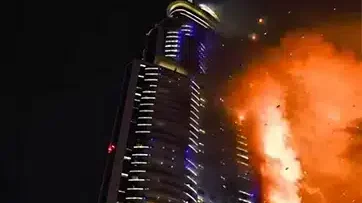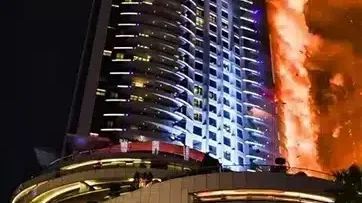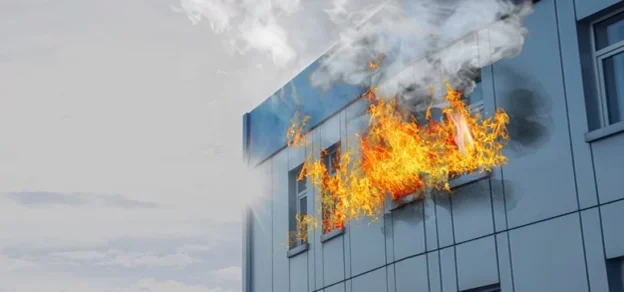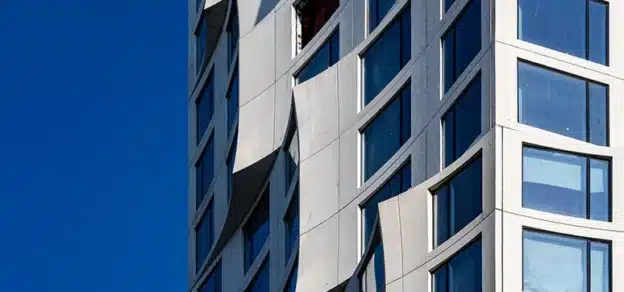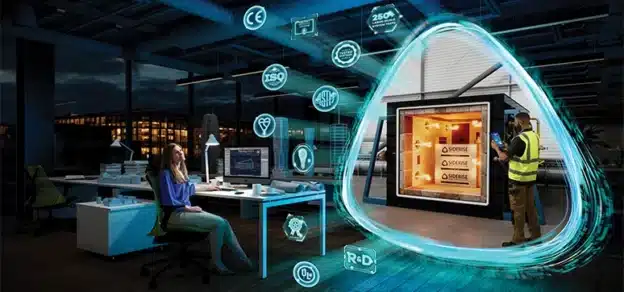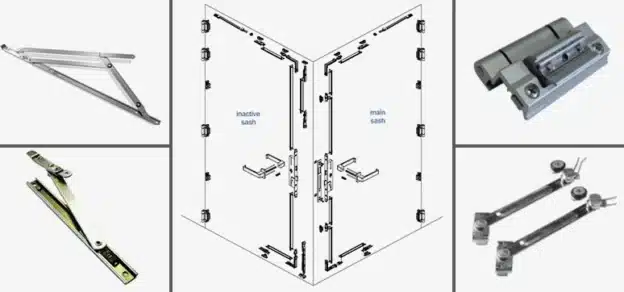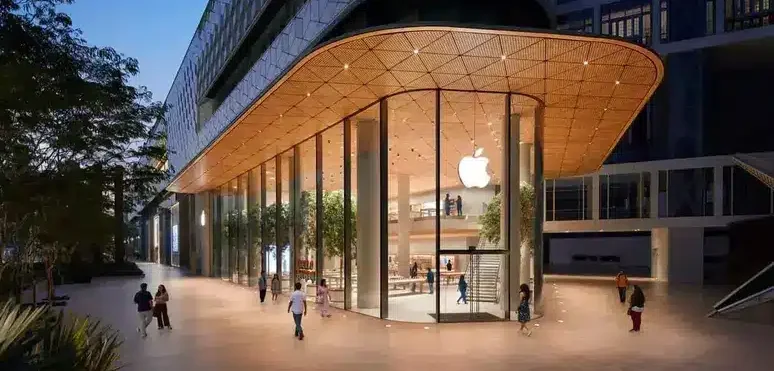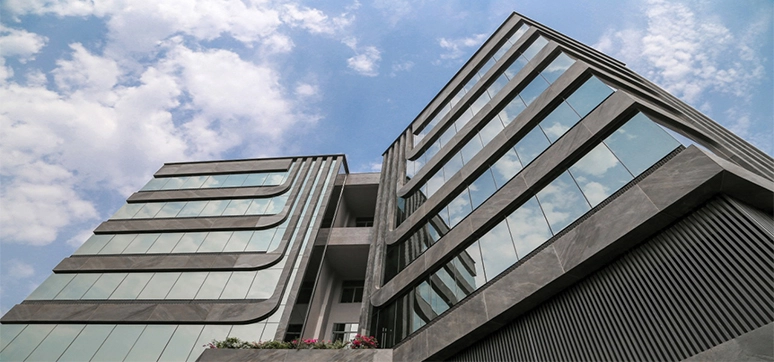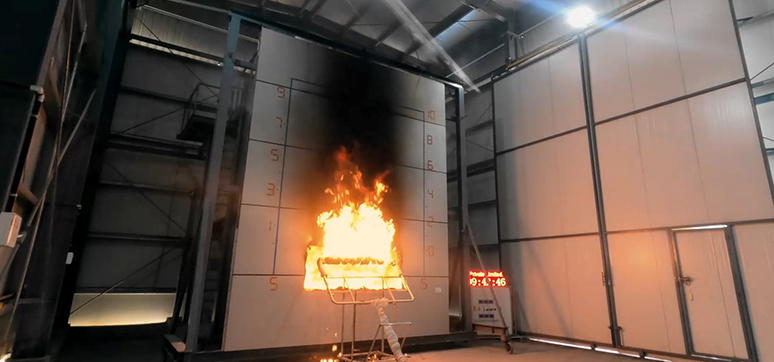On looking at the literal meaning of the ‘façade & fenestration’ it is known that façade means “the front wall of a large building that you see from the outside” or “the way somebody/ something appears to be, which is not the way it really is”. It may be seen that in many of the so called commercial buildings, it is not the front wall alone, but the buildings having glass façades on all sides. The meaning of fenestrations is “the arrangement, proportioning & design of windows & doors in a building”. This part i.e.“windows” was seen totally missing in most of the glass façade buildings built in the past.

Roll of Walls/Façade
The role played by the external walls or façade of any building, especially in the event of an outbreak of fire, becomes more relevant in such buildings. The balconies are a regular feature in normal buildings. This feature is normally missing in the glass façade building. The external walls protect a building from the external climatic conditions and keep the interior comfortable for the people living in the building. The buildings need to be strong enough to face the extreme climatic conditions, to which the area is likely to be exposed.
We also need to have natural light ventilation, a clean environment, parking space, space for movement of fire engines, and water for firefighting, etc. The requirements in these regards are well defined and specified in the NBC. Most of these requirements are the same for glass façades, as well as other buildings, however, it is the internal division of the building, which makes the notable difference, so far as fire safety and means of escape are concerned.
This difference is mainly because the normal office buildings have a central corridor, ventilated on both ends and with rooms on either side. The space above the false ceiling is normally used for AC ducts and other services. The rooms are provided with a number of doors as per the size and occupancy of the rooms. The arrangement is more or less similar in the case of institutional buildings (hospitals – for the wards, OPD etc.) These may however have other internal arrangements for the utilisation of the available space in the required manner.
Buildings in IT Sector
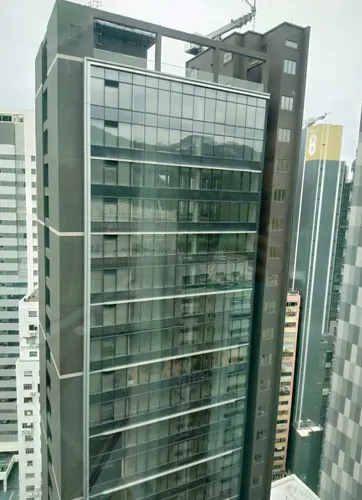
The business/ office buildings in IT sector normally have huge floor space, only separated by a few feet high partitions. The large-sized floors are provided with air-conditioning through AC ducts provided in the space above the false ceiling. The buildings are also provided with fire suppression facilities, as required under the law. The people, who are likely to use the fire & life safety arrangements before arrival of fire service will depend on the fact, whether people are on 24×7 working, with or without sleeping risk, or 8 hours working during the day shift only.
The Scenario in Case of Fire
Fire in a normal building having walled construction:
The incident normally starts as a small fire, which may spread to the entire room of origin. The smoke and heat start filling the room, and the accumulation of the smoke and hot gases will take place near the ceiling level. The smoke and heat will remain confined to that room, if there are no openings in the floors or the walls, below or above the false ceiling. The sprinkler provided in the room at ceiling level will come into operation within a minute as the temperature reaches about 68° C.
This smoke and heat may travel to other rooms in the same zone, i.e. rooms which are served by the same Air Handling Units (AHU), even if the AHU is designed to stop through an auto-tripping, on the operation of the automatic fire alarm system. Provision of a fire damper at every entry and return air passage in each room may however keep the smoke and fire confined to the room of origin for a reasonable time depending on many other factors.
Effect of the Internal Spread of Smoke
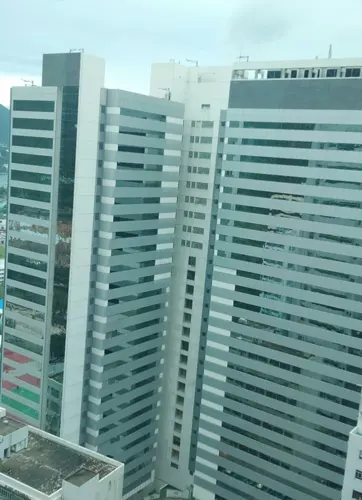
The main effect of smoke is the reduction in visibility, difficulty in breathing & panic, etc. for the occupants. Any delay in the beginning of evacuation or commencement of the fire fighting process is likely to make the egress by the occupants as well as entry for the firemen for rescue or fire fighting difficult. Can it be managed externally (without entering the building), or by using portable means of smoke venting? Certainly not. Then what is the solution? It is possible by having built in facilities for natural or mechanical smoke venting or smoke management facility, which can be used in the event of a fire. Are we taking care of this as of now? Perhaps not.
The air-conditioning requirements of a glass façade building are different in terms of the size/volume of the internal compartments. The spread of smoke from a small/ slow fire in a large volume compartment may take more time to reduce the visibility to a difficult level but a fast-spreading fire or delayed action in tackling the incident may result in difficulty for the people in the building as well as firemen responding on to the fire call.
The Present Arrangement
We mostly do not have any special facility to manage the smoke and hot gases in the event of a fire, even in the hospital buildings, where the evacuation of the inpatients can be extremely difficult or rather impossible. The openable windows can certainly be useful in certain situations. The provision of the openable windows was not mandatory for the glass façade buildings till recently. This provision of one square meter openable window hinged at the top and at a distance of 10 meters along the periphery has been recommended in the NBC 2016.
The Utility of Such Openings
The ventilators provided in the glass façade are manually openable and not designed to open automatically in case of fire. Moreover, these windows are provided at about 1-meter height and not near the Ceiling level hence, these may not be very useful for the smoke venting purpose. The wind direction too may affect adversely, during fire conditions and there has to be someone present inside the building to open these windows, if needed.
Apparently, these openable windows may not serve the required purposes so far as the venting out the smoke is concerned. External access to such windows may not be possible beyond certain heights of buildings, then What is the Solution?
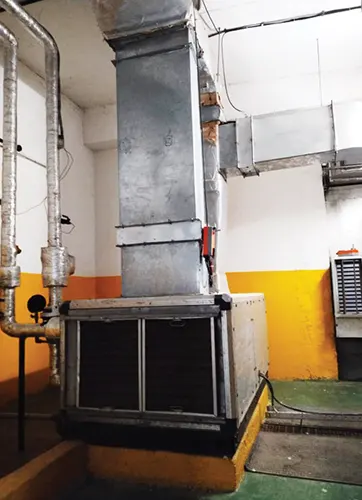
We know that physical compartmentation is not feasible in office/ business buildings, due to the requirement of such building occupants for better utilisation of the space. We may consider the compartmentation at the ceiling level, by way of creating physical inverted barriers/ coffers. These coffers may be connected to the ventilation ducts having a fire/ smoke damper at the entrance of the duct, to provide effective smoke venting, built into the design.
We may certainly use a combined central A/C system for the existing buildings, using the supply ducts to serve as mechanical venting ducts also, thereby reducing the overall cost as well. This can be easily arranged by adding a few pieces of ducts and a few dampers in the AHU room, of old buildings, as illustrated in the figure. There will however be a need for fresh air replenishment near the floor level at appropriate suitable location.
The Past Experience of Fires
The past experience shows that the fire starting in the Sprinklered buildings, remained confined to the room of Origin only. The problem starts mainly due to carelessness when the sprinkler control valves are closed or there is no water in the system. The fire services invariably must face the smoke, hot gases & poor or nil visibility condition on arrival at the Fire scene. Most of them are not even equipped with PPEs for personal protection or thermal imaging facility for entering smoke-filled premises.
The options, therefore, are to either throw water from outside or somehow try to vent out the heat & smoke in the access corridors/ stairs etc. and then use breathing apparatus sets, make entry to get within the reach of the room on fire & use minimum water to extinguish the fire. The built in natural or mechanical venting system with effective segregation/ compartmentalization can make things easy for people using the building as well as for the fire service, responding to the fire call.
- The experience we have gone through are – AMRI Hospital fire in 2011 in Kolkata – 93 deaths
- Sunrise Hospital, Dream Mall Covid Hospital 2021 in Mumbai – 12 deaths out of 78 rescued by fire department
- Upahar Cinema Fire -1997 in Delhi – 59 deaths, out of over 125 rescued and
- Sidharth Continental Hotel Fire in Delhi- 1986. about 37 people lost their life.
All of them in these Fire incidents died due to inhalation of Smoke & other product of combustion and no-one was burnt by fire. These deaths were understood to be the result of two main factors:
- Lack of effective compartmentation/ unsealed openings, which allowed the smoke to spread to other areas in the building. The locked means of escape added to the number of causalities in the Sidharth Hotel fire.
- The lack of openable windows or absence of natural or mechanical ventilation in those parts of the building, where people were trapped and could not escape in time. There was a large-sized fixed glass window in the balcony foyer, located at the rear side of the centrally A/C cinema-hall, had no openable windows. The toughened glass could not be broken by the trapped public & they got suffocated to death. Fire was in an electrical transformer at the stilt floor, not inside the cinema hall.
These are not the only incidents as there are many more incidents to quote, which lead to the death of many people due to smoke from fires, mostly in centrally air-conditioned buildings
Conclusion
All glass façade buildings are required to be provided with a centrally air conditioned facility as an operational requirement. We, therefore, need prevent the spread of smoke/ fire through glass façade joints with the floors as well as the possibility of internal spread of smoke & fire, to other than fire affected part of building through central AC system ducts or unsealed service shafts, etc. Effective smoke management needs effective compartmentalization of means of escape & AC zones, below as well above the false ceiling.
The need for the built-in automatic smoke venting must be given desired importance for the life safety of the occupants, along with good maintenance & function ability of all the systems like fire alarm, communication, sprinkler and other water or gas-based fire suppression systems for the centrally air conditioned & glass façade buildings. External assistance may not be considered dependable at all. The awareness about the fire hazards present in the building, the information about the means of escape, fire suppression facilities and smoke venting, etc., on part of the occupants, can help in easy evacuation & save precious lives in the event of a fire.




